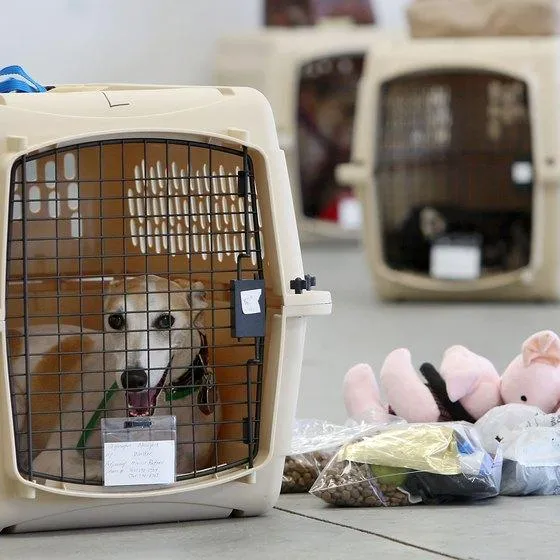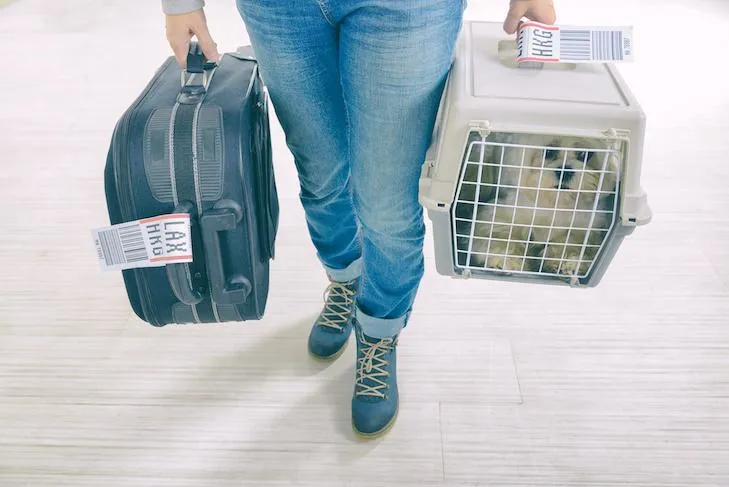Traveling With Your Dog By Air: Everything You Need to Know About Airline Kennels
If you want to take your furry friend along on your next flight, using an airline kennel is essential. But the kennel process can seem daunting if you’ve never done it before. In this article, I’ll answer all the common questions dog owners have about airline kennels and provide tips to make traveling with your pooch by plane as stress-free as possible.
What is an Airline Kennel?
An airline kennel, also sometimes called a “carrying crate,” is a sturdy plastic or metal container that is specifically designed and approved for transporting small to medium sized dogs on commercial aircraft. Kennels are required by all major airlines to keep your dog safe and contained during takeoffs, landings, and taxiing when they are in the cargo hold with luggage.
Standard kennel sizes are approximately test measurements like 20″ x 14″ x 11″. But it’s important to double check the exact maximum dimensions with your airline, as requirements can vary slightly. The kennel must be big enough for your dog to stand up and turn around in comfortably, but not too big as to allow excessive movement during turbulence.
How to Choose the Right Kennel
When selecting a kennel, look for these features:
- Smooth, rounded edges to protect your dog from injury
- Ventilated sides for airflow
- Locking door that will not accidentally open during transport
- Handles on the top and sides for easy carrying
I also recommend getting a dark or opaque kennel to reduce stress from surrounding sights and sounds. Your dog should be fully able to stand up without their ears touching the top.
Kennel Training Your Dog
Once you have the kennel, it’s important to get your pup acclimated to it before the big travel day. Start by feeding them in it and giving treats near the entrance. Gradually work up to having them enter, get treats, and exit. Keep these first sessions short and positive. Over time, you can increase the duration your dog is comfortable spending in the kennel.

You can also use familiar clothes or blankets that smell like you inside to make it feel safe and cozy. The goal is for the kennel to seem like a happy, relaxing place rather than a crate for punishment. With patience and positive reinforcement, most dogs adapt well to kennel training.
Recommendations for Flying with Your Dog
From my experiences traveling with canine companions, here are some extra tips to help things go smoothly:
- Always check your airline’s specific rules and restrictions on flying with pets. Things like size, weight, health records, quarantine if traveling abroad all vary.
- Consider using a sedative prescribed by your vet to reduce stress, but only if truly necessary as some dogs can experience disorientation from them.
- Bring plenty of water for your pup during long layovers or delays. Pet relief areas may not always be available.
- Attach ID tags on their collar and on the outside of the kennel with your contact information in case of emergency.
- Try to book nonstop flights to reduce potential for lost luggage with transfers.
And don’t forget to bring a favorite toy or blanket to comfort them! Proper prep usually leads to smooth sailing, or should I say flying, with furry friends.
Potential Issues and What to Do
No battle plan survives contact with the enemy, as they say. It’s possible bumps may occur along the way. Here are some common problems and solutions:
- Delayed or canceled flight: Contact the airline right away for assistance or alternate arrangements like overnight boarding.
- Lost luggage: Ensure proper ID and stay at the airport ready to be contacted. Most carriers tag pets differently to expedite finds.
- Signs of distress: Watch for heavy panting/crying. Request the gate agent check on your pup if concerned with climate control.
Basically, don’t panic. Stay calm and keep the lines of comm with airline staff open. They’re usually quick to help frantic fur moms and dads. Remember that most dogs adapt fine with care. I haven’t faced major dilemmas yet, knock on wood!
Cost Considerations
Preparing for your pet’s flight does require some investment:

- Kennel purchase ($50-$150 depending on brand/features)
- Vet check/vaccine verification (varies by practice)
- Airline pet booking fees (~$125 each way per carrier with most airlines)
- Potential pet sitter/boarding if delayed or multi-leg trips
So weigh if the time, monetary costs are worthwhile compared to driving or other pet transport services. For many owners, sharing adventures with their pup is priceless. So do some research, crunch numbers, and see if flying Fido can fit your travel plans and budget!
Other Ground Transportation Options for Pets
If flying remains too much stress or hassle for your particular situation, some land alternatives exist:
- Drive yourself and break up long hauls with potty/play breaks.
- Use a professional pet transportation service that drives like PetProject or Happy Tails Travel.
- Take a train if feasible, like Amtrak that allows carriers in sleeping quarters.
- Look into commercial pet shuttle buses between major cities.
While more time intensive usually, road trips can be an adventure your canine pal joins without same flight restrictions. Go the route that suits you and your pet’s temperament best!
Final Thoughts
In summary, flying with pets requires some extra effort but opens up shared experiences that create pawsome memories. With proper planning, training and care, the majority of dogs do just fine on commercial flights. The smile you get from your tail-wagging co-pilot makes all those steps worthwhile. Safe travels to you and your furry friend!
Comparing Airline Kennel Sizes and Features
| Kennel Size | Weight Limit | Removable Pan | Ventilation | Certification |
|---|---|---|---|---|
| Small (12x18x18) | Under 20 lbs | Yes | Front zipper mesh | IATA |
| Medium (18x18x18) | 20-40 lbs | Yes | Front and side zipper mesh | IATA |
| Large (18x24x24) | 40-70 lbs | Yes | Front, side and top zipper mesh | IATA |
| Extra Large (24x24x24) | Over 70 lbs | Yes | Maximum ventilation | IATA |
FAQ
-
How long can dogs stay in airline kennels?
Most airlines allow dogs to stay in kennels for up to 8-10 hours during a flight. Any longer and it could cause some stress for the pup. At the same time, many dogs handle airplane travel pretty well.
-
Can I see my dog while we’re at the airport?
It depends on the airline. Some let you say goodbye to your pup before they’re put in the kennel for security reasons. Others have rules against any contact for a little while before boarding. Basically, check with your airline to see their specific policy on interactions with dogs at the airport.

-
How are dogs’ kennels secured on the plane?
The kennels are placed in cargo holds below the plane and securely locked or tied down so they do not move around during flights. Nevertheless, turbulence may still cause some rattling that could shake up the nervous dogs. Most experts agree that as long as kennel requirements are met, the chances of a kennel opening in flight are quite slim.
-
What type of kennel is required?
The kennel must be big enough for your dog to stand up, turn around, and lie down in comfortably. It also needs to be made of materials strong enough that your pup cannot chew or break through. Kind of like an airplane-approved “doggy jail cell”! Most pet stores sell kennels that fit airline specifications. Always check the requirements for your specific airline to be safe.
-
Is it cruel to put dogs in cargo?
There is some debate around this. While cargo is generally warmer than the cabin, some animal experts argue that extended periods of close confinement can be stressful for pups. However, many seasoned dog owners insist their pups handled cargo just fine. Perhaps dogs are smart enough to “go with the flow” and trust their humans have their best interests at heart? There are good arguments on both sides, so maybe the truth lies somewhere in the middle.
-
What if my dog is really anxious?
If your pup has known anxiety issues, discuss options with your vet. Medication administered by your vet can help keep anxiety at bay for flights. Some airlines also offer a “calming jacket” that applies light pressure, which studies show helps reduce stress for dogs. It’s worth talking to the airline about any special needs well ahead of your scheduled flight. Our furry friends deserve to fly as comfortably as possible!
-
Is there an age limit for dogs flying?
While many airlines allow dogs as young as 8 weeks old, others have minimum age rules of 16-20 weeks due to health and immunity considerations. Also, very young pups sometimes struggle with long periods confined in small spaces. So check with your specific airline and follow guidance from your vet about the best age to fly junior pooches based on their needs. Age limits are there to protect the wee ones, after all.
-
Should I sedate my dog for the flight?
Unless advised by your vet, it’s best not to sedate dogs for flights. Drug reactions are possible, and many experts agree that animals do better facing things awake versus unconscious. For anxious pups, calming aids are preferable to full sedatives if used correctly per vet guidance. In the end, you know your dog best – have an honest chat with the vet about what’s right in each unique situation.

